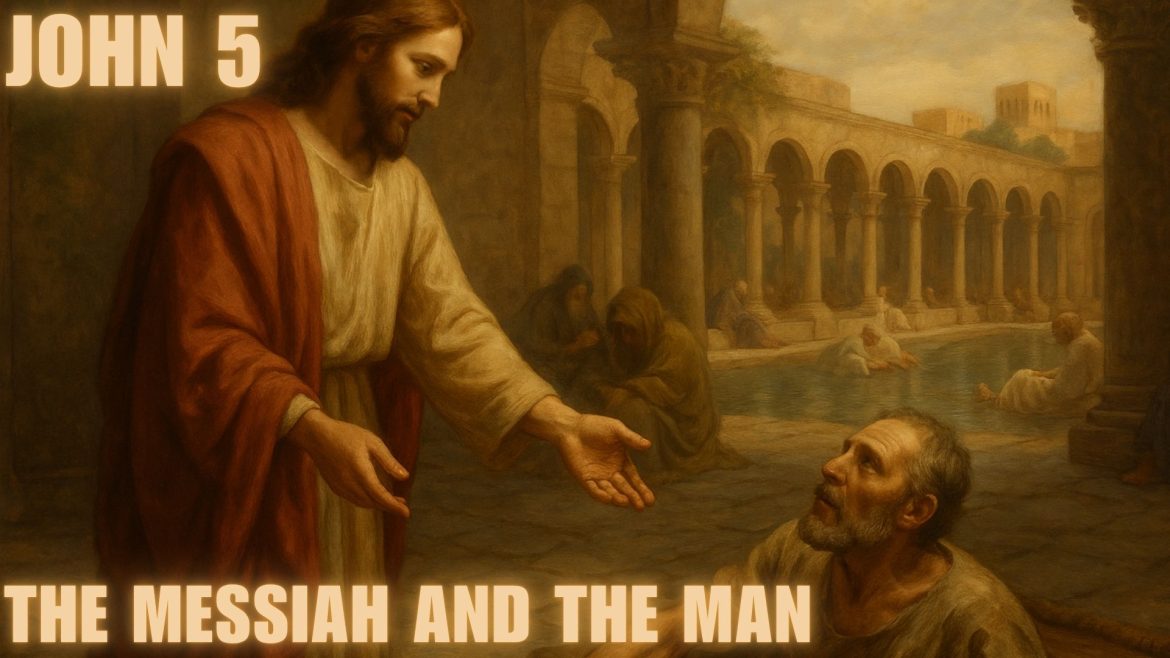Imagine sitting by a pool for decades, hoping for healing that never arrives. This is the emotional and spiritual tension captured in John 5, where Jesus heals a man at the pool of Bethesda. This moment, seemingly simple, unfolds into a deep narrative about mercy, legalism, and divine authority. It challenges us to consider not just the miraculous, but what it means to be truly healed—body and soul.
The Setting: A Place of Broken Hope
John 5 opens with Jesus entering Jerusalem during a Jewish feast. Near the Sheep Gate is a pool called Bethesda, meaning “House of Mercy.” It was believed that when the water stirred, the first person to enter would be healed. This scene isn’t just historical; it’s deeply symbolic. People waited here with shattered hopes, clinging to legends, longing for a miracle.
The Man by the Pool: A Life Defined by Waiting
Jesus meets a man who has been disabled for 38 years. When asked if he wants to be healed, the man doesn’t say “yes”—he explains why he can’t get to the water. That response is telling. He isn’t defiant; he’s resigned. Yet Jesus skips the ritual and offers healing without condition: “Take your mat and walk.” It’s instant. It’s complete. It’s mercy unfiltered.
Sabbath Conflict: Rules vs. Relationship
Of course, controversy follows. The healed man is rebuked—not celebrated—because he carries his mat on the Sabbath. Religious leaders were more upset about rule-breaking than the miracle itself. This clash reveals how holiness can become hollow when compassion is removed. Jesus wasn’t just healing bodies; he was exposing hearts.
Jesus’ Bold Claim: Divine Unity
The confrontation escalates when Jesus declares, “My Father is working, and so am I.” This was more than a defense; it was a declaration of divinity. He wasn’t just healing like God—He was healing as God. Jesus teaches that He and the Father are united in purpose and essence. That’s why He heals on the Sabbath: mercy never clocks out.
Eternal Stakes: More Than Physical Healing
Jesus moves from physical healing to spiritual transformation. He tells the healed man to “sin no more,” linking health to holiness, not as a threat but as an invitation. Then He declares that those who hear His voice will live—not just in the future, but now. It’s a radical shift: eternal life isn’t postponed, it begins in the present.
The Scriptures Speak of Jesus
In challenging the religious leaders, Jesus says the scriptures they revere point to Him. Even Moses, whom they idolize, would accuse them of missing the Messiah. This isn’t about rejecting rules—it’s about recognizing the Redeemer. The law was a signpost; Jesus is the destination.
Application for Today: Mercy in the Mundane
So what does this mean for us? First, we learn that mercy can come uninvited. The man didn’t ask Jesus for healing, yet he received it. That’s grace. Second, religious rules should never override compassion. We must ask: are we honoring God, or merely our traditions?
And finally, healing is holistic. Jesus cares about both your body and your soul. He invites us not just to walk, but to walk in newness of life.
Conclusion: Recognizing the Heart of God
John 5 isn’t just about one man’s miracle—it’s about the mission of Jesus. He shows us that God’s heart is merciful, always working, always healing, always calling us to life. When we understand Jesus, we understand the Father. And when we respond to His call, we find more than healing—we find home.

